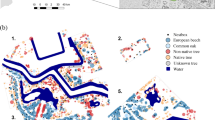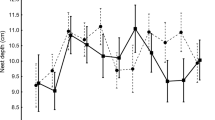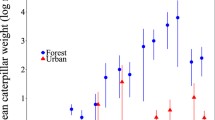Abstract
The effects of habitat gaps on breeding success and parental daily energy expenditure (DEE) were investigated in great tits (Parus major) and blue tits (Cyanistes caeruleus) in urban parkland (Cardiff, UK) compared with birds in deciduous woodland (eastern England, UK). Tree canopy height, the percentage of gap in the canopy and the percentage of oak (in the wood only) within a 30 m radius of nest boxes were obtained from airborne remote-sensed data. Breeding success was monitored and parental DEE (great tits: both habitats; blue tits: park only) was measured using doubly labelled water in birds feeding young. In the park, mean (±SD) tree height (7.5 ± 4.7 m) was less than in the wood (10.6 ± 4.5 m), but the incidence of gaps (32.7 ± 22.6%) was greater (9.2 ± 14.7%). Great tits and blue tits both reared fewer young in the park and chick body mass was also reduced in park-reared great tits. Park great tits had a higher DEE (86.3 ± 12.3 kJ day−1) than those in the wood (78.0 ± 11.7 kJ day−1) and, because of smaller brood sizes, worked about 64% harder for each chick reared. Tits in the park with more than about 35% gap around their boxes had higher DEEs than the average for the habitat. In the wood, great tits with less oak around their boxes worked harder than average. Thus structural gaps, and functional gaps generated by variation in the quality of foraging habitat, increased the costs of rearing young.




Similar content being viewed by others
References
Ackermann F (1999) Airborne laser scanning – present status and future expectations. ISPRS J Photogramm Remote Sens 54:64–67
Alexander K, Butler J, Green T (2006) The value of different tree and shrub species to wildlife. Brit Wildl 18:18–28
Andrén H (1992) Corvid density and nest predation in relation to forest fragmentation: a landscape perspective. Ecology 73:794–804
Bradbury RB, Hill RA, Mason DC, Hinsley SA, Wilson JD, Balzter H, Anderson QA, Whittingham MJ, Davenport IJ, Bellamy PE (2005) Modelling relationships between birds and vegetation structure using airborne LiDAR data: a review with case studies from agricultural and woodland environments. Ibis 147:443–452
Broughton RK, Hinsley SA, Bellamy PE, Hill RA, Rothery P (2006) Marsh Tit territory structure in a British broadleaved woodland. Ibis 148:744–752
Bryant DM, Tatner P (1991) Intraspecific variation in avian energy expenditure: correlates and constraints. Ibis 133:236–245
Burke DM, Nol E (1998) Influence of food abundance, nest-site habitat, and forest fragmentation on breeding ovenbirds. Auk 115:96–104
Carleer A, Wolff E (2004) Exploitation of very high resolution satellite data for tree species identification. Photogramm Eng Remote Sens 70:135–140
Cowie RJ, Hinsley SA (1987) Breeding success of blue tits and great tits in suburban gardens. Ardea 75:81–90
Daan S, Masman D, Groenewold A (1990) Avian basal metabolic rates: their association with body composition and energy expenditure in nature. Am J Physiol 259:333–340
Daan S, Deerenberg C, Dijkstra C (1996) Increased daily work precipitates natural death in the kestrel. J Anim Ecol 65:539–544
Desrochers A, Hannon SJ (1997) Gap crossing decisions by forest songbirds during the post-fledging period. Conserv Biol 11:1204–1210
Dhondt AA, Eyckerman R, Moermans R, Hublé J (1984) Habitat and laying date of the Great Tit and Blue Tit (Parus major and Parus caeruleus). Ibis 126:388–397
Dias PC, Blondel J (1996) Breeding time, food supply and fitness components of Blue Tits Parus caeruleus in Mediterranean habitats. Ibis 138:644–649
Ehrlich PR, Wilson EO (1991) Biodiversity studies: science and policy. Science 253:758–762
Eybert MC, Constant P, Lefeuvre JC (1995) Effects of changes in agricultural landscape on a breeding population of linnets Acanthis cannabina L. living in adjacent heathland. Biol Conserv 74:195–202
Fischbacher M, Naef-Daenzer B, Naef-Daenzer L (1998) Estimating caterpillar density on trees by collection of frass droppings. Ardea 86:121–129
Fuller RM, Groom GB, Jones AR (1994) The Land Cover Map of Great Britain: an automated classification of Landsat Thematic Mapper data. Photogramm Eng Remote Sens 60:553–562
Gardiner C, Sparks T (eds) (2005) Ten years of change: woodland research at Monks Wood NNR, 1993–2003. In: Proceedings of the 50th anniversary symposium. English Nature Research Report 613. English Nature, Peterborough
George M (2005) Tree species classification from remote sensing data. Dissertation, University of Leicester
Goldstein DL (1990) Energetics of activity and free living in birds. In: Morrison ML, Ralph CJ, Verner J, Jehl JR (eds) Avian foraging: theory, methodology and applications. studies in avian biology no 13. Cooper Ornithological Society, Los Angeles, pp 423–426
Hammond KA, Diamond J (1997) Maximal sustained energy budgets in humans and animals. Nature 386:457–462
Haywood S, Perrins CM (1992) Is clutch size in birds affected by environmental conditions during growth? Proc R Soc Lond B 249:195–197
Heywood VH (eds) (1995) Global biodiversity assessment. United Nations Environment Programme. Cambridge University Press, Cambridge
Hill RA, Smith GM, Fuller RM, Veitch N (2002) Landscape modelling using integrated airborne multi-spectral and elevation data. Int J Remote Sens 23:2327–2334
Hill RA, Hinsley SA, Gaveau DLA, Bellamy PE (2004) Predicting habitat quality for Great Tits (Parus major) with airborne laser scanning data. Int J Remote Sens 25:4851–4855
Hinsley SA (2000) The costs of multiple patch use by birds. Landsc Ecol 15:765–775
Hinsley SA, Bellamy PE, Moss D (1995) Sparrowhawk Accipiter nisus predation and feeding site selection by tits. Ibis 137:418–420
Hinsley SA, Rothery P, Bellamy PE (1999) Influence of woodland area on breeding success in Great Tits Parus major and Blue Tits Parus caeruleus. J Avian Biol 30:271–281
Hinsley SA, Hill RA, Bellamy PE, Balzter H (2006) The application of LiDAR in woodland bird ecology: climate, canopy structure and habitat quality. Photogramm Eng Remote Sens 72:1399–1406
Keller LF, van Noordwijk AJ (1994) Effects of local environmental conditions on nestling growth in the great tit Parus major L. Ardea 82:349–362
Kennedy CEJ, Southwood TRE (1984) The number of species of insect associated with British trees: a re-analysis. J Anim Ecol 53:455–478
Lambrechts MM, Caro S, Charmantier A, Gross N, Galan M-J, Perret P, Cartan-Son M, Dias PC, Blondel J, Thomas DW (2004) Habitat quality as a predictor of spatial variation in blue tit reproductive performance: a multi-plot analysis in a heterogeneous landscape. Oecologia 141:555–561
Lefsky MA, Cohen WB, Parker GG, Harding DJ (2002) Lidar remote sensing for ecosystem studies. BioScience 52:19–30
Lim K, Treitz P, Wulder M, Stonge B, Flood M (2003) LiDAR remote sensing of forest structure. Prog Phys Geog 27:88–106
Lindén M, Gustafsson L, Pärt T (1992) Selection on fledging mass in the Collared Flycatcher and the Great Tit. Ecology 73:336–343
Lindström Å, Kvist A (1995) Maximum energy intake rate is proportional to basal metabolic rate in passerine birds. Proc R Soc Lond B 261:337–343
Lloyd DG (1987) Selection on offspring size at independence and other size-versus-number strategies. Am Nat 129:800–817
Lõhmus A (2003) Are certain habitats better every year? A review and case study on birds of prey. Ecography 26:545–552
McCollin D (1998) Forest edges and habitat selection in birds: a functional approach. Ecography 21:247–260
Merilä J, Wiggins DA (1997) Mass loss in breeding blue tits – the role of energetic stress. J Anim Ecol 66:452–460
Mickelson JG, Civco DL, Silander JA (1998) Delineating forest canopy species in the northeastern United States using multi-temporal TM imagery. Photogramm Eng Remote Sens 64:891–904
Mills GS, Dunning JB, Bates JM (1989) Effects of urbanization on breeding bird community structure in southwestern desert habitats. Condor 91:416–428
Moreno J, Cowie RJ, Sanz JJ, Williams RSR (1995) Differential response by males and females to brood manipulation in the Pied flycatcher: energy expenditure and nestling diet. J Anim Ecol 64:721–732
Næsett E. (2004). Practical large-scale forest stand inventory using small-footprint airborne scanning laser. Scand J Forest Res 19:164–179
Naef-Daenzer B (2000) Patch time allocation and patch sampling by foraging great and blue tits. Anim Behav 59:989–999
Naef-Daenzer L, Nager RG, Keller LF, Naef-Daenzer B (2004) Are hatching delays a cost or a benefit for Great Tit Parus major parents? Ardea 92:229–237
Nilsson J-Å (2002) Metabolic consequences of hard work. Proc R Soc Lond B 269:1735–1739
Peck KM (1989) Tree species preferences shown by foraging birds in forest plantations in northern England. Biol Conserv 48:41–57
Perrins CM (1979) British tits. Collins, London
Perrins CM (1991). Tits and their caterpillar food supply. Ibis 133(suppl 1):49–54
Reichard SH, Chalker-Scott L, Buchanan S (2001) Interactions among non-native plants and birds. In: Marzluff JM, Bowman R, Donnelly R (eds) Avian ecology and conservation in an urbanizing world. Kluwer Academic Publishers, pp 179–223
Riddington R, Gosler AG (1995) Differences in reproductive success and parental qualities between habitats in the Great Tit Parus major. Ibis 137:371–378
Sanz JJ, Tinbergen JM, Orell M, Rytkönen S (1998) Daily energy expenditure during brood rearing of great tits (Parus major) in Northern Finland. Ardea 86:101–107
Schmidt K-H, Steinbach J (1983) Niedriger Bruterfolg der Kohlmeise (Parus major) in städtischen Parks und Friedhöfen. J Ornithol 124:81–83
Schoech SJ, Bowman R (2001) Variation in the timing of breeding between suburban and wildland Florida scrub jays: do physiologic measures reflect different environments? In: Marzluff JM, Bowman R, Donnelly R, (eds) Avian ecology and conservation in an urbanizing world. Kluwer Academic Publishers, pp 289–306
Slagsvold T, Amundsen T, Dale S (1995) Costs and benefits of hatching asynchrony in blue tits Parus caeruleus. J Anim Ecol 64:563–578
Speakman JR (1997) Doubly labelled water: theory and practice. Chapman and Hall, London
Speakman JR (1998) The history and theory of the doubly labelled water technique. Am J Clin Nutr 68(suppl):S932–S938
Stauss MJ, Burkhardt JF, Tomiuk J (2005) Foraging flight distances as a measure of parental effort in blue tits Parus caeruleus differ with environmental conditions. J Avian Biol 36:47–56
Thomas DW, Blondel J, Perret P, Lambrechts MM, Speakman JR (2001) Energetic and fitness costs of mismatching resource supply and demand in seasonally breeding birds. Science 291:2598–2600
Tinbergen JM, Boerlijst MC (1990) Nestling weight and survival in individual great tits (Parus major). J Anim Ecol 59:1113–1127
Tinbergen JM, Dietz MW (1994) Parental energy expenditure during brood rearing in the Great Tit (Parus major) in relation to body mass, temperature, food availability and clutch size. Funct Ecol 8:563–572
Tinbergen JM, Verhulst S (2000) A fixed energetic ceiling to parental effort in the great tit? J Anim Ecol 69:323–334
Treitz P, Howarth P (2000) Integrating spectral, spatial and terrain variables for forest ecosystem classification. Photogramm Eng Remote Sens 66:305–317
Tremblay I, Thomas DW, Lambrechts MM, Blondel J, Perret P (2003) Variation in blue tit breeding performance across gradients in habitat richness. Ecology 84:3033–3043
Tremblay I, Thomas DW, Blondel J, Perret P, Lambrechts MM (2005) The effect of habitat quality on foraging patterns, provisioning rate and nestling growth in Corsican Blue Tits Parus caeruleus. Ibis 147:17–24
van Balen JH (1973) A comparative study of the breeding ecology of the Great Tit Parus major in different habitats. Ardea 61:1–93
Vane-Wright RI, Humphries CJ, Williams PH (1991) What to protect? Systematics and the agony of choice. Biol Conserv 55:235–254
Verhulst S, Tinbergen JM (1997) Clutch size and parental effort in the great tit Parus major. Ardea 85:111–126
Verhulst S, Tinbergen JM (2001) Variation in food supply, time of breeding, and energy expenditure in birds. Science 294 (Technical Comments) 471a. Full text available from http://www.Sciencemag.org/cgi/content/full/294/5542/471a
Wehr A, Lohr U (1999) Airborne laser scanning–an introduction and overview. ISPRS J Photogramm Remote Sens 54:68–82
Wolter PT, Mladenoff DJ, Host GE, Crow TR (1995) Improved forest classification in the northern lakes states using multi-temporal Landsat imagery. Photogramm Eng Remote Sens 61:1129–1143
Wright J, Both C, Cotton PA, Bryant D (1998) Quality vs. quantity: energetic and nutritional trade-offs in parental provisioning strategies. J Anim Ecol 67:620–634
Zandt HS (1994) A comparison of three sampling techniques to estimate the population size of caterpillars in trees. Oecologia 97:399–406
Acknowledgements
We would like to thank the Esmée Fairbairn Foundation for funding the DLW procedure. Thanks also to Natural England (especially Chris Gardiner), Cardiff City Council, (especially Chris Powell and Jonathan Green), and David Gaveau. The LiDAR data for Monks Wood were supplied by the Environment Agency, and the ATM data by the NERC Airborne Research and Survey Facility (ARSF). The LiDAR data for Bute Park were supplied by the NERC ARSF in conjunction with the Unit for Landscape Modelling at the University of Cambridge. Analysis of all remote sensed data was carried out whilst RAH was based at CEH Monks Wood. The DLW procedure, trapping and storage of samples were carried out under licences issued to SAH: Home Office Licence PPL 80/1756; Natural England: 20030897 & 20040579; Countryside Council for Wales: OTH: SB:03:2003, OTH:SB:02:2004 & OTH:SB:03:2005.
Author information
Authors and Affiliations
Corresponding author
Electronic supplementary material
Below is the link to the electronic supplementary material.
Rights and permissions
About this article
Cite this article
Hinsley, S.A., Hill, R.A., Bellamy, P.E. et al. Effects of structural and functional habitat gaps on breeding woodland birds: working harder for less. Landscape Ecol 23, 615–626 (2008). https://doi.org/10.1007/s10980-008-9225-8
Received:
Accepted:
Published:
Issue Date:
DOI: https://doi.org/10.1007/s10980-008-9225-8




